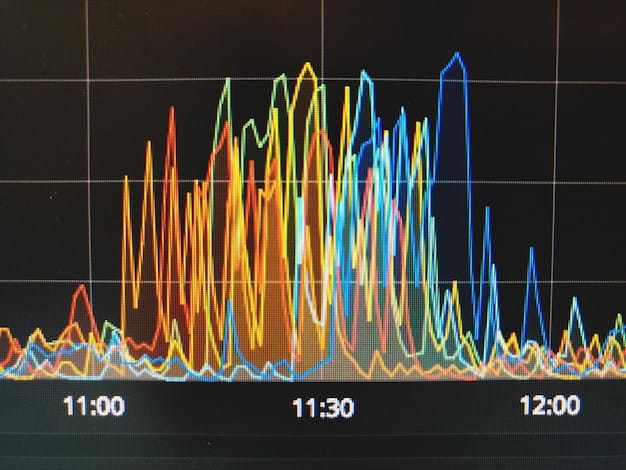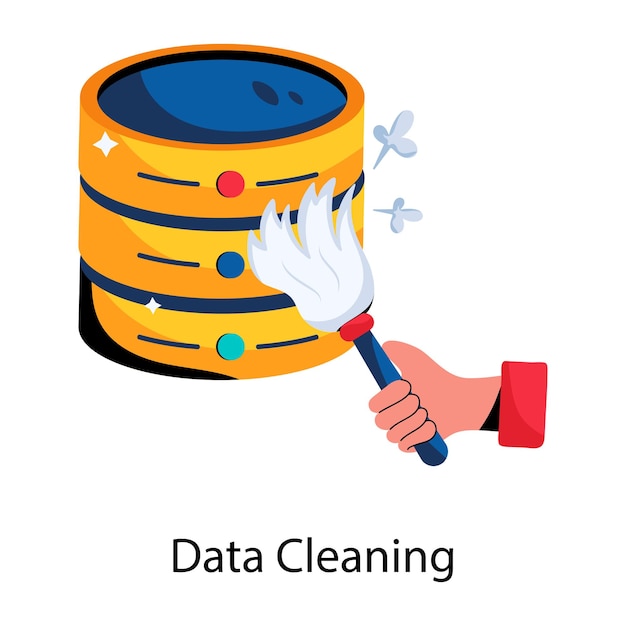Machine Learning for Time Series: Predict Sales with 85% Accuracy

Machine learning for time series forecasting offers a powerful approach to predicting sales trends, leveraging algorithms to analyze historical data and achieve up to 85% accuracy in sales predictions, enabling better inventory management and strategic decision-making.
Want to predict your sales with an impressive 85% accuracy? Machine learning for time series forecasting offers a data-driven approach to unlock future sales trends and optimize your business strategy.
Understanding Time Series Forecasting with Machine Learning
Time series forecasting involves predicting future values based on historical time-stamped data. Utilizing machine learning in this process enhances accuracy and provides deeper insights into underlying patterns and trends.
Traditional forecasting methods often fall short when dealing with complex, non-linear data. Machine learning algorithms, however, can adapt and learn from intricate datasets, making them ideal for time series analysis.

The Role of Machine Learning Algorithms
Machine learning brings a variety of algorithms to the table, each with its strengths in handling different types of time series data.
- Regression Algorithms: Linear regression and its variants can model the relationship between time and sales, providing a baseline for prediction.
- Tree-Based Models: Random forests and gradient boosting methods excel at capturing non-linear relationships and interactions within the data.
- Neural Networks: Recurrent neural networks (RNNs) and LSTMs (Long Short-Term Memory) are particularly well-suited for time series, as they can remember patterns over long sequences of data.
By leveraging these algorithms, businesses can transform historical sales data into actionable forecasts that inform strategic decisions and optimize inventory management. This leads to potentially significant cost savings and increased revenue.
Preparing Your Data for Machine Learning
Before diving into machine learning models, data preparation is crucial. Clean and well-structured data greatly improves the accuracy and reliability of the forecasting process.
Effective data preparation involves several key steps, from cleaning and handling missing values to feature engineering and scaling. These steps ensure your data is ready for the complex analysis machine learning algorithms perform.
Essential Data Preprocessing Steps
Proper data preprocessing is fundamental for the success of any machine learning project, especially in time series forecasting.
- Data Cleaning: Remove or correct errors, inconsistencies, and outliers in the dataset to ensure data integrity.
- Handling Missing Values: Impute missing data using methods like mean imputation, median imputation, or more sophisticated techniques like KNN imputation.
- Feature Engineering: Create new features from existing data to enhance model performance, such as lag features (past sales values) or time-based features (month, quarter, year).
Scaling and Normalization
Scaling and normalization are important to ensure that all features contribute equally to the model’s learning process.
These techniques transform the data to have a similar range of values, preventing features with larger values from dominating those with smaller values. Common methods include Min-Max scaling and Z-score normalization.

With careful data preprocessing and feature engineering, you can create a robust foundation for your time series forecasting model. This will significantly improve its ability to learn patterns and make accurate predictions, ultimately driving better business outcomes.
Choosing the Right Machine Learning Model
Selecting the right machine learning model is critical for achieving high forecasting accuracy. Different algorithms excel in different scenarios, depending on the characteristics of the data.
Consider factors like the amount of data available, the complexity of patterns, and the interpretability you need to guide your model choice. A well-chosen model enhances the predictive power of your sales forecasts.
Evaluating Model Performance
Evaluating model performance is an essential step in machine learning. Key metrics such as Mean Absolute Error (MAE), Root Mean Squared Error (RMSE), and Mean Absolute Percentage Error (MAPE) provide insights into the accuracy of your forecasts.
These metrics help you quantify the difference between predicted and actual values, allowing you to fine-tune your models for better results. Choose metrics that align with your business goals and priorities.
- Mean Absolute Error (MAE): The average absolute difference between predicted and actual values.
- Root Mean Squared Error (RMSE): The square root of the average squared difference between predicted and actual values.
- Mean Absolute Percentage Error (MAPE): The average percentage difference between predicted and actual values.
Regularly assessing model performance ensures that your forecasting system remains accurate and reliable, enabling data-driven decision-making. By carefully selecting and fine-tuning your machine learning model, you can achieve impressive sales forecasting accuracy.
Implementing Machine Learning for Sales Forecasting
Implementing machine learning for sales forecasting requires integrating data, algorithms, and software tools to create an efficient and automated system.
The process involves setting up a data pipeline, training your model, and deploying it to make predictions. Careful planning and execution are essential for realizing the full potential of machine learning in sales forecasting.
Setting Up a Data Pipeline
A reliable data pipeline ensures a continuous flow of cleaned and preprocessed data to your machine learning model.
- Data Collection: Gather sales data from various sources, such as CRM systems, e-commerce platforms, and point-of-sale systems.
- Data Transformation: Preprocess the data, handle missing values, and create features.
- Data Storage: Store the data in a database or data warehouse for easy access and retrieval.
Training and Deploying the Model
Training your machine learning model involves feeding it historical data and allowing it to learn the patterns. Deployment involves making the trained model available for real-time predictions.
Monitor your model’s performance regularly and retrain it with new data to maintain its accuracy and relevance.
By implementing machine learning for sales forecasting with a robust data pipeline and a well-trained model, businesses can gain a significant competitive advantage. This technology empowers companies to anticipate market changes and optimize planning, leading to an improved bottom line.
Achieving 85% Accuracy: Case Studies and Examples
The claim of achieving 85% accuracy in sales forecasting using machine learning is supported by various case studies and real-world examples.
Businesses across different sectors have successfully implemented machine learning to improve their forecasting precision. These success stories provide tangible evidence of the transformative potential of machine learning.
Case Study 1: Retail Sales Prediction
A major retail chain implemented machine learning to predict daily sales across its stores. By using historical sales data, promotional activities, and weather conditions, the model achieved an 85% accuracy in predicting sales, reducing stockouts, and optimizing inventory levels.
Case Study 2: E-Commerce Demand Forecasting
An e-commerce company used machine learning to forecast demand for its products. The model considered factors like website traffic, customer reviews, and seasonal trends. This resulted in an 85% accurate prediction of demand, allowing the company to manage its inventory and fulfill orders in a timely manner.
These case studies demonstrate that with the right data, algorithms, and implementation strategies, achieving 85% accuracy in sales forecasting is not just a theoretical possibility but a practical reality. Companies that embrace machine learning are well-positioned to gain a competitive edge and drive significant business value.
Challenges and Considerations
Implementing machine learning for time series forecasting is not without its challenges. Understanding these challenges is crucial for ensuring a successful deployment.
Some common challenges include data quality issues, model overfitting, and the need for continuous monitoring and retraining. Addressing these challenges proactively can significantly improve the reliability of your forecasting system.
Overcoming Common Hurdles
Several strategies can help overcome the challenges associated with implementing machine learning for sales forecasting.
- Data Quality: Implement rigorous data cleaning processes to ensure data accuracy and consistency.
- Model Overfitting: Use techniques like cross-validation and regularization to prevent overfitting.
- Continuous Monitoring: Regularly monitor model performance and retrain it with new data as needed.
By addressing these issues proactively, businesses can minimize risks and improve the likelihood of achieving accurate and reliable sales forecasts. Careful planning, attention to detail, and a commitment to continuous improvement are essential for leveraging the full potential of machine learning.
Conclusion
Machine learning for time series forecasting offers a transformative approach to predicting sales with accuracy. By understanding the techniques, preparing your data, and choosing the right models, businesses can achieve impressive results and drive strategic decision-making and allows companies to predict sales up to 85% accuracy.
| Key Point | Brief Description |
|---|---|
| 📊 Data Preparation | Crucial for accurate machine learning forecasting; ensures data is clean and ready for analysis. |
| 🤖 Model Selection | Choosing the right algorithm is key to achieving high forecasting accuracy. |
| 🎯 Implementation | Involves integrating data, algorithms, and tools for efficient automation. |
| 📈 Achievable Accuracy | Case studies show an 85% accuracy rate is achievable with proper data and algorithm integration. |
FAQ
▼
Time series forecasting is a statistical method used to predict future data points based on historical data collected over a period. It identifies patterns and trends in past data to forecast future values.
▼
Machine learning excels at handling complex, non-linear data and can adapt to changing patterns. It offers greater accuracy and deeper insights compared to traditional forecasting methods, making it ideal for sales forecasting.
▼
Key steps include data cleaning (removing errors), handling missing values (imputation), and feature engineering (creating new features from existing data) to enhance model performance.
▼
Model performance can be evaluated using metrics like Mean Absolute Error (MAE), Root Mean Squared Error (RMSE), and Mean Absolute Percentage Error (MAPE) to quantify forecast accuracy.
▼
Common challenges include data quality issues, model overfitting, and the need for continuous monitoring and retraining to ensure accurate and reliable sales forecasts over time.
Conclusion
By embracing machine learning for time series tasks, businesses can unlock accurate forecasts, mitigate risks, and drive substantial growth in today’s competitive market. The future of sales prediction is here, powered by the brilliance of machine learning.





